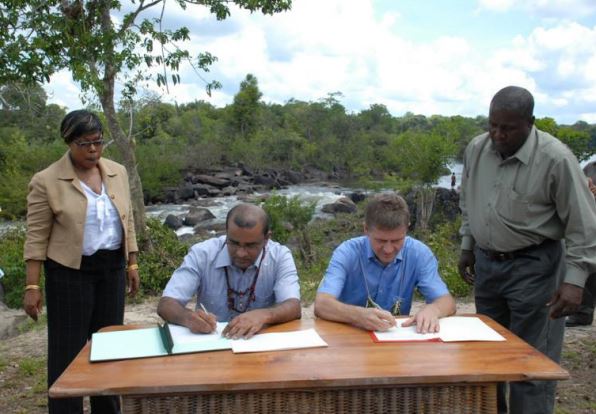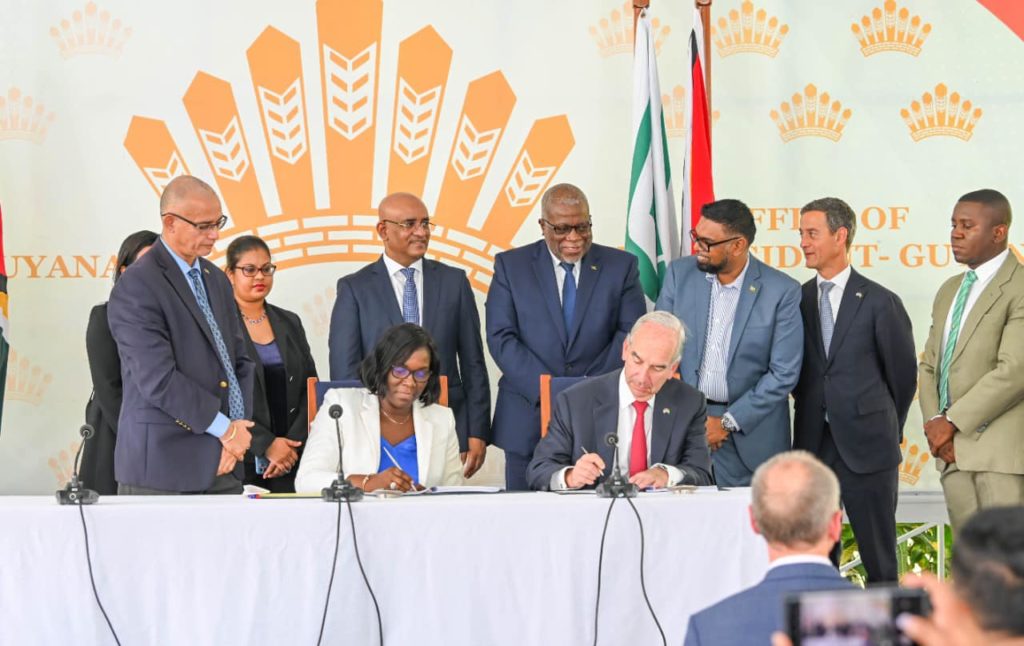President, Vice President in Dubai for Climate Summit. Why?
By Neil Marks in Dubai
President Irfaan Ali and Vice President Bharrat Jagdeo are among leaders who have arrived in Dubai for the annual climate summit of the United Nations.
Why are they here? It can’t be because they want to escape the heat. This place is HOT!
And besides, they were 27 of these summits before. Why is there another? Isn’t this a talk shop?
Long before Guyana stunned the world with its prolific oil discoveries and began earning big from the production of oil more than 100 miles in the ocean, it was famous for something else on land– its trees.
These trees cover 85% of its landmass – the size of Britain. Other countries have bulldozed their jungles to develop lands for large-scale projects, such as agriculture and mining, because they need to lift people out of poverty and earn money to do things like building roads and bridges and other activities to develop their economies.

Guyana has argued that you can make big money to develop without cutting down the trees. And that’s a big reason why the President and Vice President have travelled here.
This is the centerstage for any and everything about forests and why they should not be cut down; and it’s also the place where you can find the people to put money into Guyana.
This idea of paying countries for the services its forests provide is not new. It has been championed by Dr Jagdeo when he was in President.
In fact, it was back in 2006 at a summit of Commonwealth Finance Ministers held in Georgetown that Dr Jagdeo made a forest pledge: Guyana would keep the forests standing if money could be earned by doing so.
And he has walked up and down these climate summits to get the world to understand the vital role of forests in protecting planet earth from climate change, particularly with its forests sucking in carbon dioxide, one of the gases that causes climate change, bringing about extreme weather events such as fires and flooding never seen before.

Guyanese may not understand the ‘nitty gritty’ of climate change, but they feel it and it can be ruthless. Just think back to 2005 when a great flood devastated the coast. The destruction it caused was put at about US$500 million – half of the annual cost to run the country at the time. Some 290,000 people were affected, almost half of the country’s population.
Today, many communities are reeling from the prolonged dry season, with water tanks having to be bought for some so they can store water. The dry spell has driven up prices for fruits and vegetables, with sources of fresh water at dangerous low levels. And the many bush fires have scared many.
In fact, at the opening of the climate summit in Dubai Thursday, the United Nations Secretary General Antonio Guterres pointed out that 2023 will be the hottest year in history.
Our biggest weakness to climate change is perhaps the rising sea. At high tide, the coast, where most people live and where most government and private business takes place, is a good five to six feet below sea level. Money is needed to build up the concrete seawall that keeps the ocean out and maintain and expand the system of canals to flush water out when there are heavy downpours that overwhelm the system.

Development Erik Solheim, signing an agreement where Norway would provide
Guyana with result-based payments for forest climate services (Photo taken from digital copy of LCDS 2030)
Norway was the first country to buy into then President Jagdeo’s crusade for forest payments, signing a US$250 million deal back in 2009. That signing came with the launch of the Low Carbon Development Strategy (LCDS), designed as a model for the world. No country anywhere else had produced such a strategy that could demonstrate how trees can be worth more alive than dead.
The money from the forest-saving deal with Norway would go into several projects to benefit indigenous and local communities.
But a better deal was needed to get more money. There was need for a mechanism to put a price to every ton of carbon stored in our trees and then offer that up for sale.

That was achieved, and a year ago, the American firm Hess Corporation bought in, agreeing to pay Guyana USD$750 million for the carbon stored in its trees. But that was just 30% of the carbon; there is much more on offer.
In 2021, President Ali launched a refined model of the LCDS with a vision towards 2030. His idea is that Guyana can lead the way in the Caribbean and further afield in the areas of climate security, energy security and food security – basically that Guyana can come up with practical solutions to the problems the world faces.
So President Ali and Dr Jagdeo will be looking to get others to buy into LCDS 2030 and carbon credits would be a main concentration.
There could be countries and big corporations looking to offset the amount of harmful gases they are releasing into the atmosphere because of their operations and are looking for avenues that would allow them a balancing act.
Guyana could be their answer and President Ali and Vice President Jagdeo would be looking to convince them that Guyana is not just a place to buy carbon. This is a country that deliberately identified how it can help solve the climate crisis – by keeping the forests standing so it can sequester carbon – and it is acting in accordance with the solution forests provide.
And by serving that global good, the country benefits from the sale of carbon because the funding goes to support the development of the national economy and local communities in particular.
And the people Ali and Jagdeo are looking for are at this climate summit in Dubai: powerhouse leaders, owners and CEOs of the world’s most powerful companies, and many others.
Among the “others” would be those who set the rules on how the trade in carbon evolves. They include influential officials from big, developed nations as well as private sector players. Guyana wants to ensure that it gets premium price for the forests it has, because it’s not just the trees. The forests are prized for the wide range of plant and animal life and the other ecological services such as freshwater and wetlands.
“This forest has value and that value must be understood, and fairly priced,” said President Ali in an interview with the News Room in Dubai.
He insisted “a fair price structure must emerge.”





